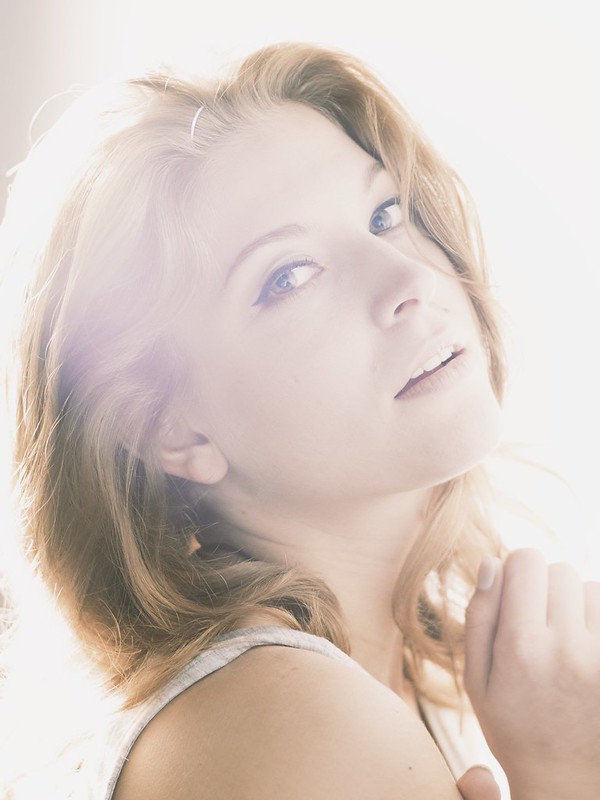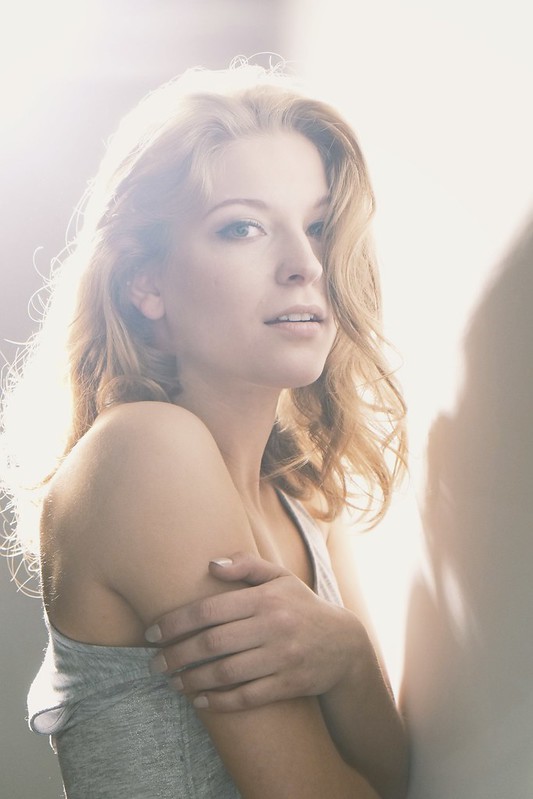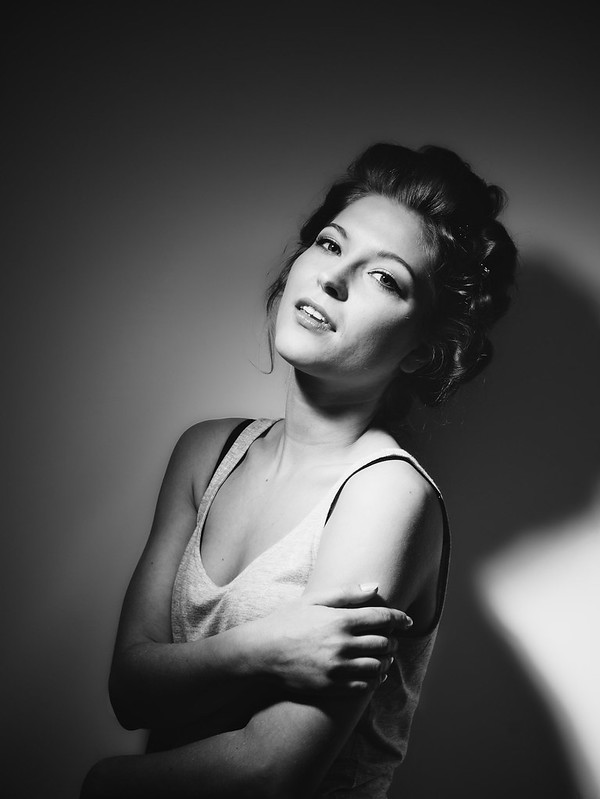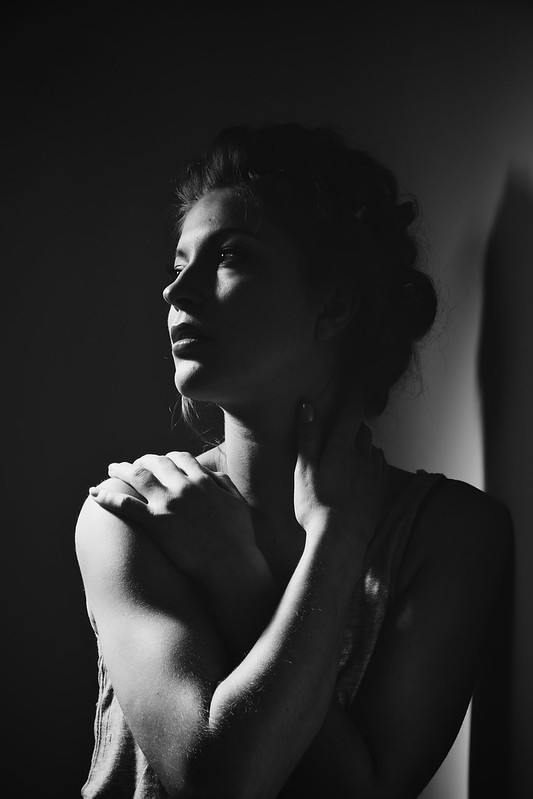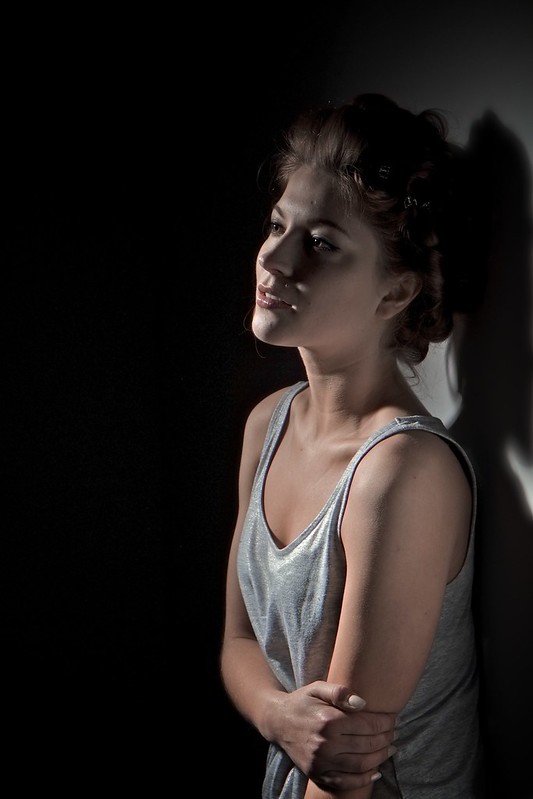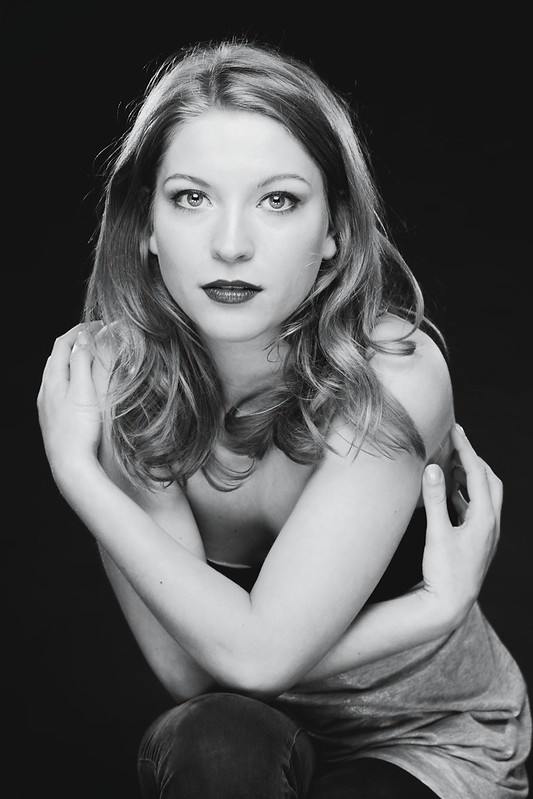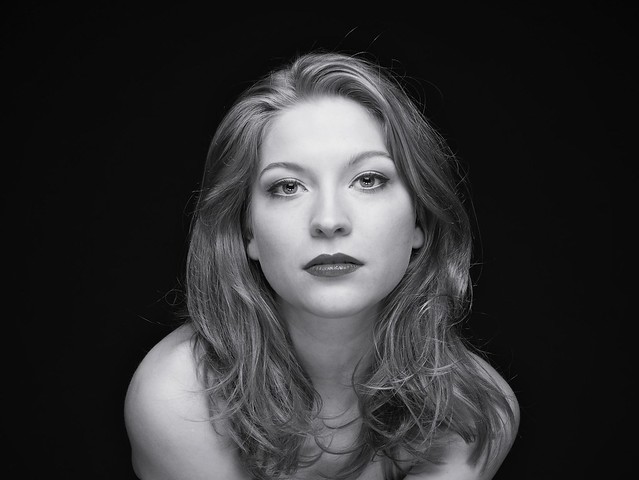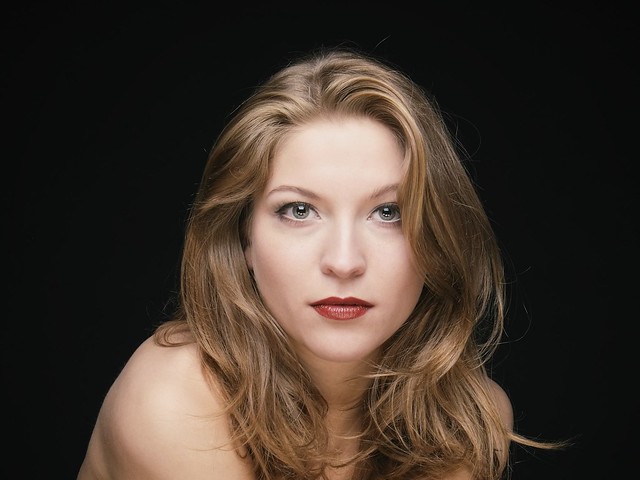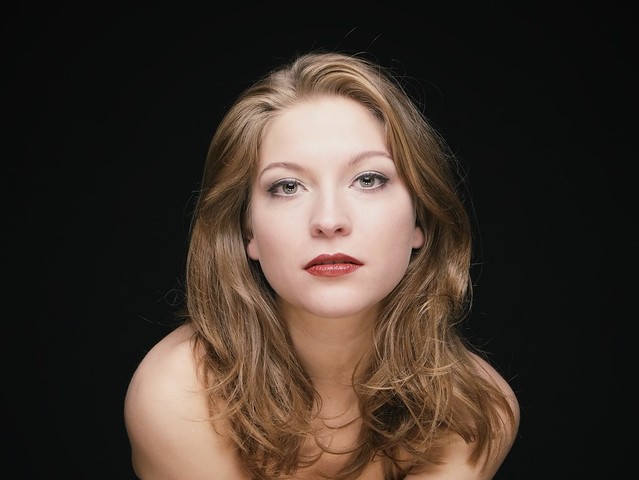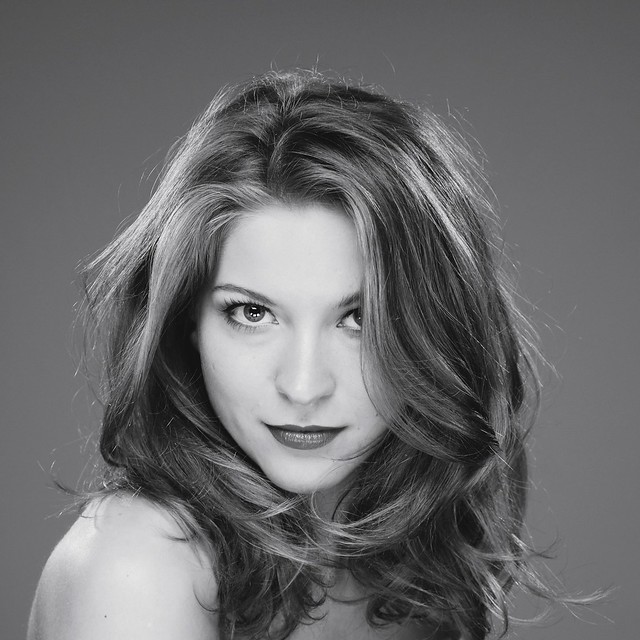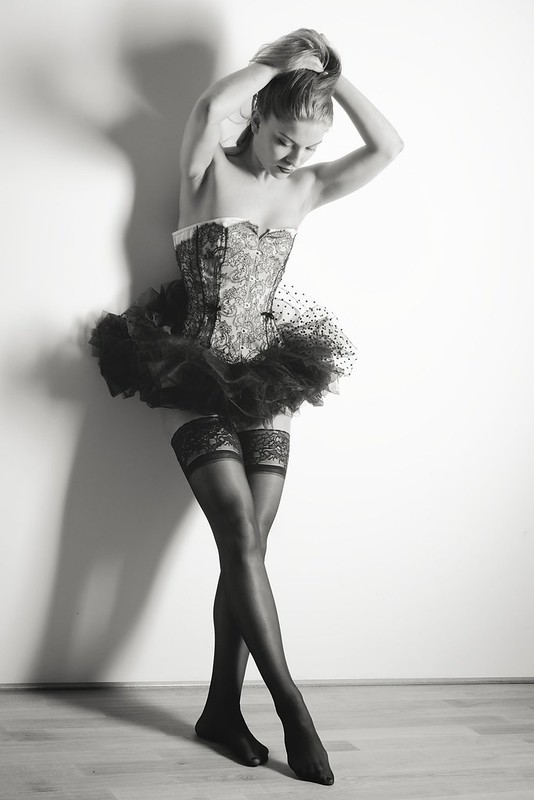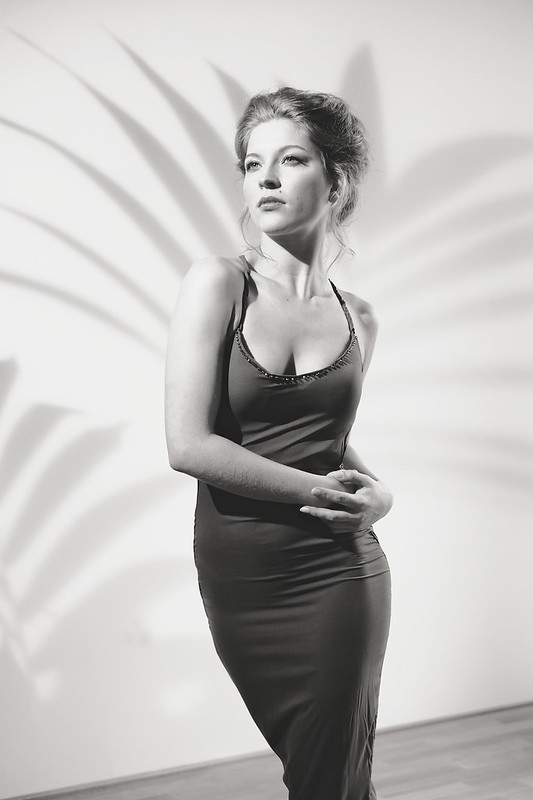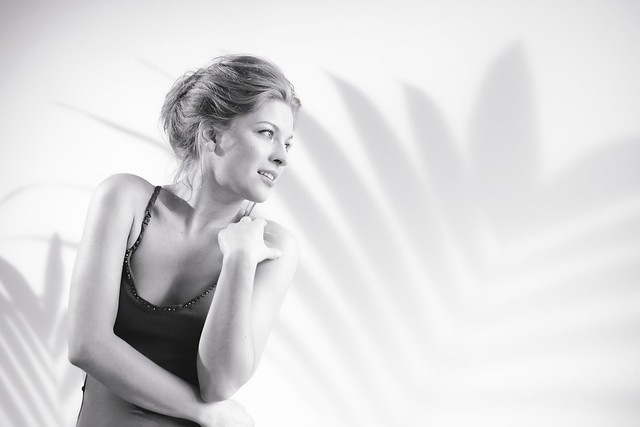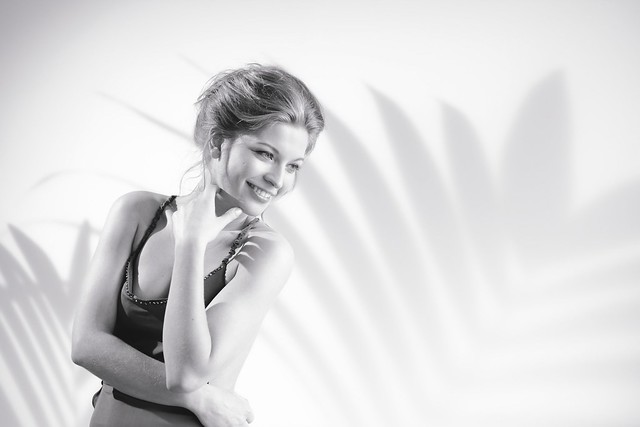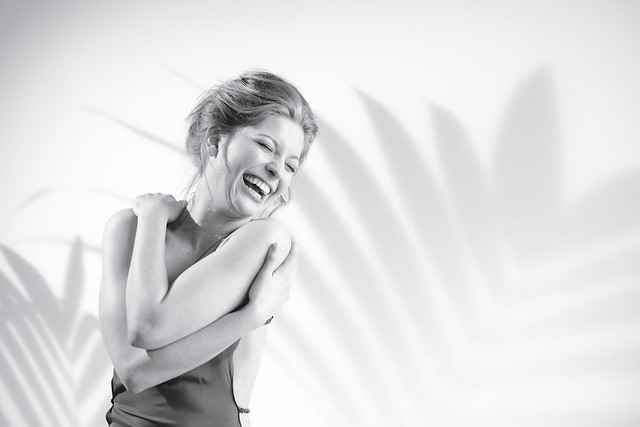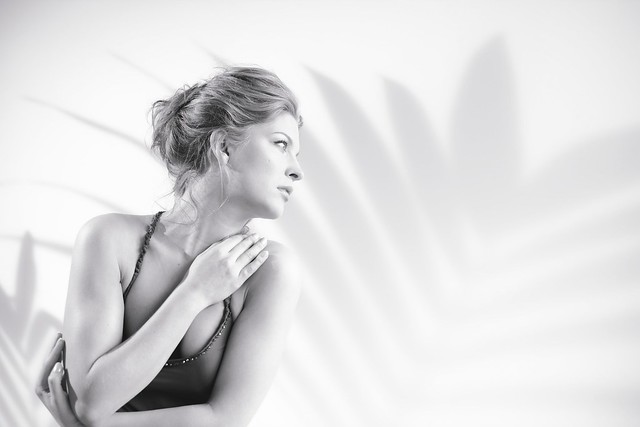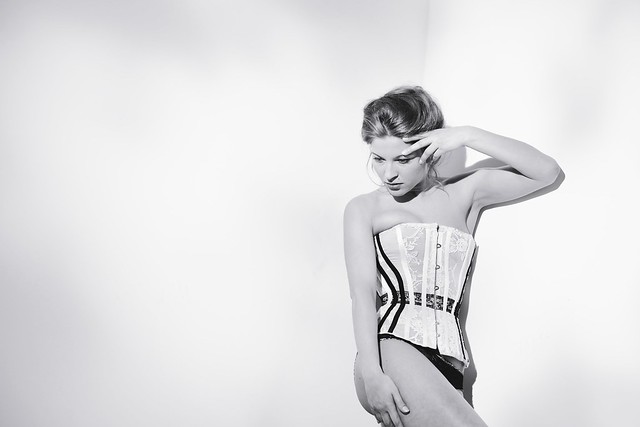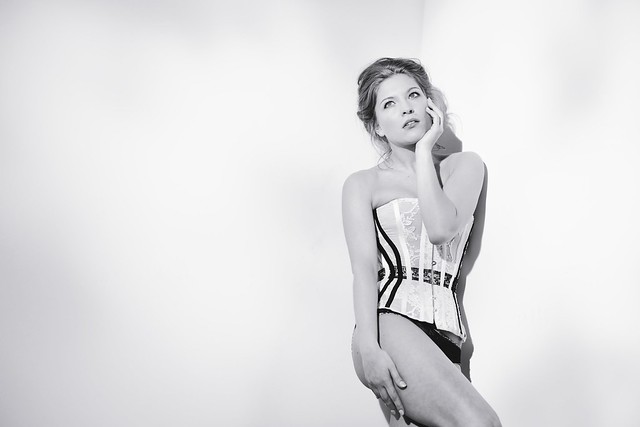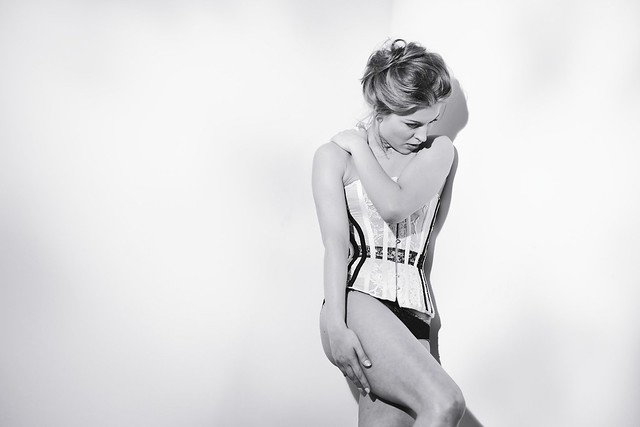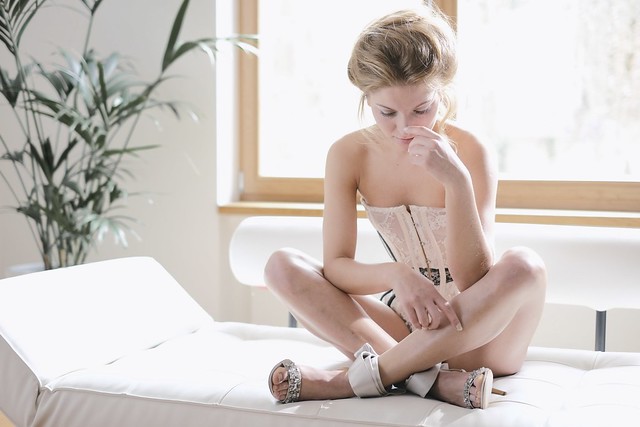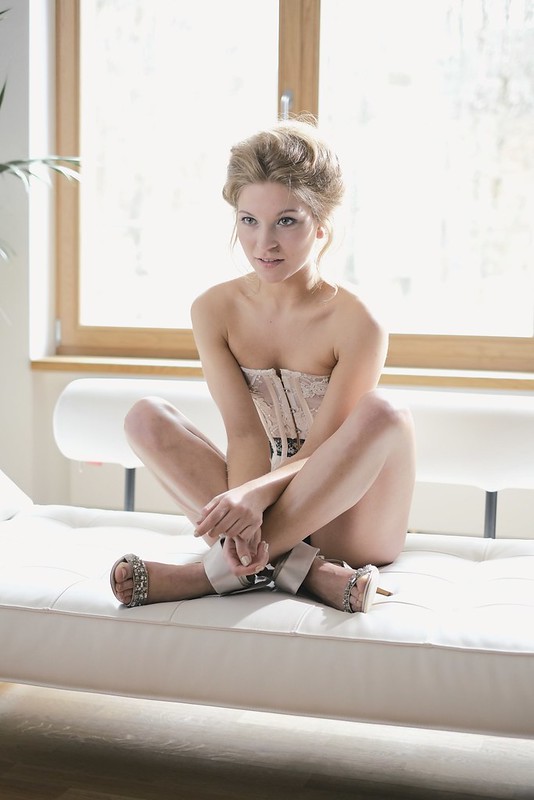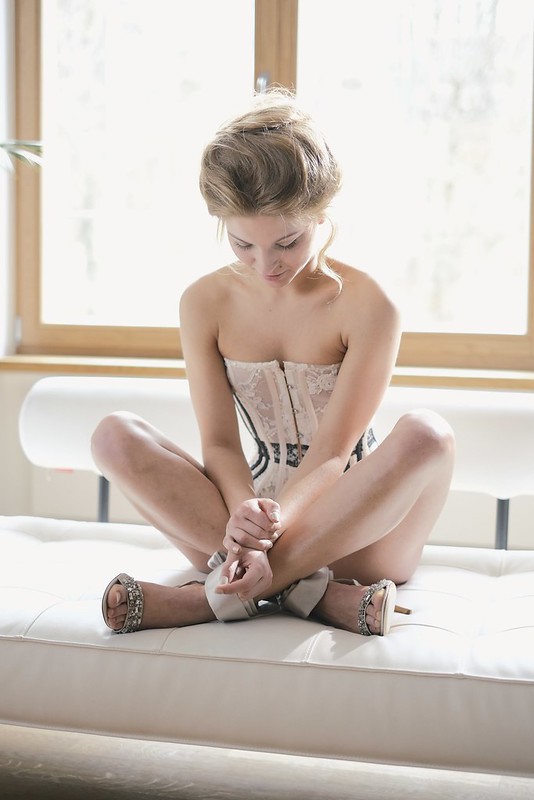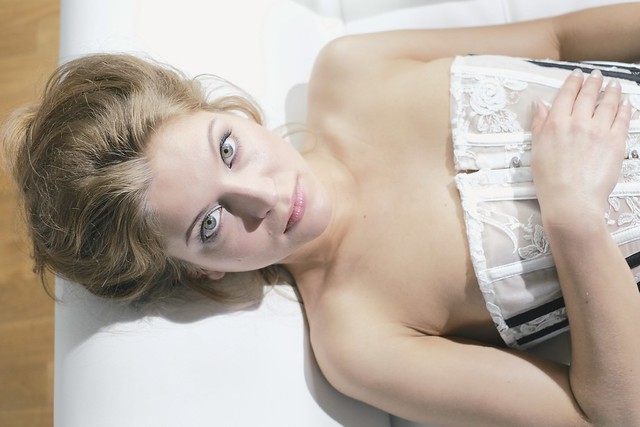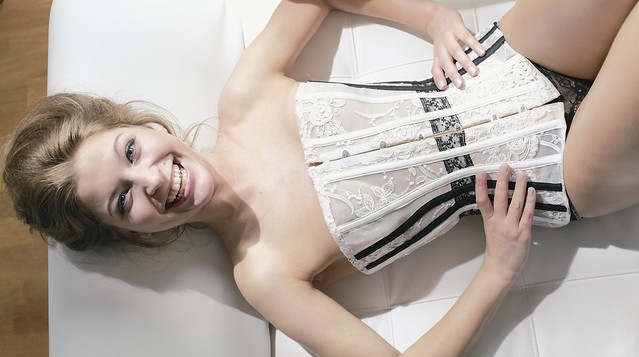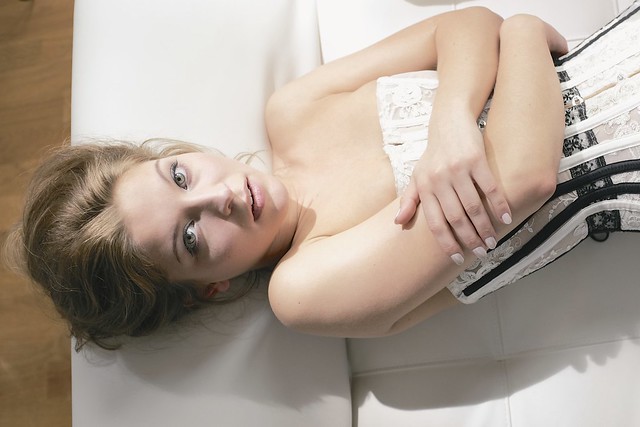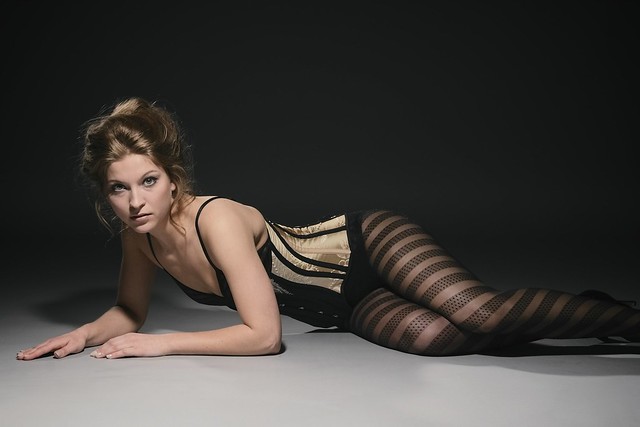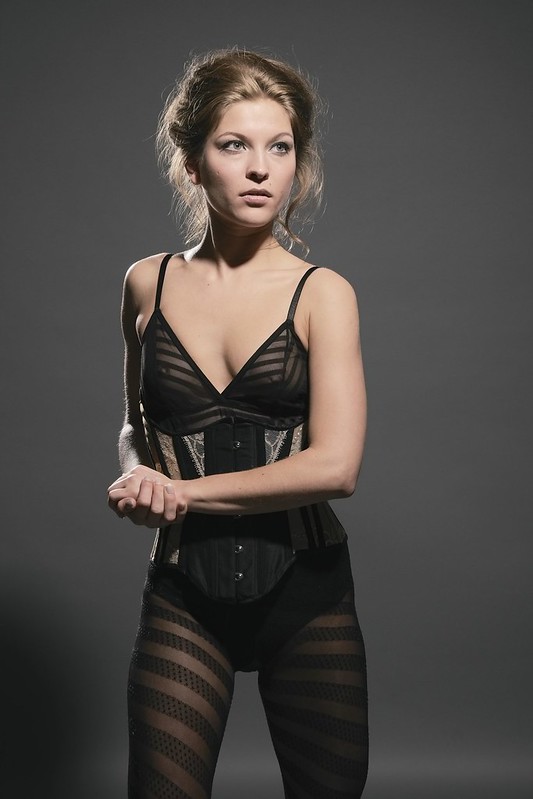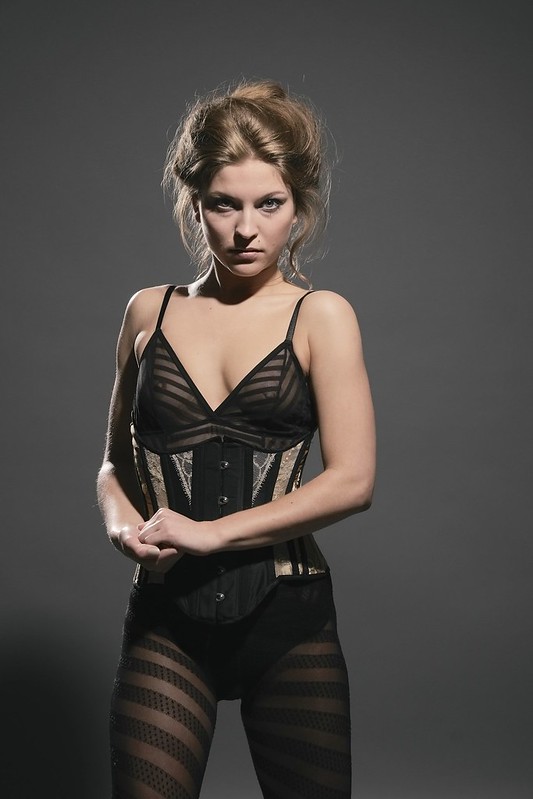Studio X
Talk to Rico (questions & feedback) – Rico’s studio samples set
Taking your X-series camera to a studio is easy. All you need is a well-equipped location, a stunning model, great make-up, amazing dresses, beautiful lighting and the talent to put it all together.
Obviously, I’ve got none of that.
That’s why I turned to Damien Lovegrove, who’s not only a master of the trade, but also a keen and experienced X-series user. When others shoot with bulky Canikons, Damien will use his classic (black) X100 or his X-Pro1. Many of his images are nothing short of spectacular and can be admired on his blog, and unlike other well-known pros, he’s not paid by Fujifilm for using and endorsing their products. Shooting the little Fujis is his choice. Here’s Damien with one of his beloved Lupolights, posing as a stand-in model:

Once I learned that Damien was coming to Munich for a lighting workshop at Radmila Kerl’s studio on April 3rd, I quickly secured myself a spot. After all, it’s just a 90 minutes drive from where I live. I brought my X-Pro1, X-E1 and X100S cameras along with a full set of lenses, eventually using Fuji’s trusted kit zoom (which Damien uses a lot), the F1.4/35mm and a classic Voigtländer Heliar F1.8/75mm with Leica M mount, which has become one of my favorite portrait lenses. Damien quickly fell in love with it, as well, but he was struggling with the manual focus of the lens. So let’s begin with a 75mm high-key shot of our stunning model Wlada Schüler from Berlin:
Lit with a single Profoto flashlight from above/behind, I used ISO 1250, f/2.8 and 1/125s flash sync on my X-E1 along with some heavy overexposure that is required for this look. Here’s another example, this time with Fuji’s kit zoom lens at 55mm and f/4.5, dialing up the X-Pro1’s ISO to 1600:
Apart from the initial Voigtländer image, all samples in this article are based on factory-setting OOC JPEGs (Provia), although I dialed down the highlight tone to -2 for several shots. The JPEGs were swiftly processed in Apple Aperture (no fancy stuff or layer work) and uploaded to Flickr.
Using the single Profoto flash unit again, but this time to create contrasty low-key results, I was closing the kit zoom’s aperture to f/9 and f/10. Careful black&white processing of the JPEGs resulted in a pleasant “film noir”-like look…
However, black&white isn’t mandatory for this kind of setting:
We shot the entire day in full manual mode, which was quite liberating given the well-documented and widely discussed Auto-ISO shortcomings of Fuji’s current firmware in the X-Pro1 and X-E1 cameras. I did use Auto White Balance for most of the shots, though, as the Fujis almost always tend to get that right. Exposing manually is quite reasonable in a setting where you can control the light and keep it steady, as this method will get you a series of identically exposed shots. Pick the ones you like, then apply the same post-processing to all of them. Of course, this procedure only works to a certain degree, as even in controlled lighting, small changes of perspective or different positions/postures of the model will lead to varying results that may require individual adjustments.
Everything was recorded in DR100%, because for shots like these, blown highlights are no problem. If they occur, it is either intentional or only affects parts of the subject where it doesn’t matter or may even enhance the shot. When you are shooting JPEGs (like I did), I recommend setting the highlight tone to -2 in order to smooth and protect bright skin tones. However, portrait photography like this is typically high-key territory, hence faces and skin are richly exposed to make them “glow”. This also enhances tonality, as the brighter parts of a digital image contain more tonal levels than the darker parts.
While manual mode is a straightforward method to expose in controlled light, Fujifilm could do a better job assisting the photographer. For starters, I’d like to see an option that enables WYSIWYG live view in manual mode, so photographers can spot actual (as opposed to measured) over- or underexposure in manual mode even before they shoot a sample. This sould go along with a working live histogram in manual mode (the current histogram is worth- and meaningless in manual mode and just blocking part of the view). Finally, I’d like to see exposure compensation working in manual mode with active Auto-ISO (which I call “misomatic” mode). In concert with the other manual mode improvements, this would also end any debate about minimum shutter speed for different focal lengths when using Auto-ISO.
“If you got a lemon, make lemonade.”
This popular proverb also applies to studio shooting, where experimenting and failure are part of the creative process. Take this Elinchrom multi-flash setup, where Damien used a purple gel to illuminate the gray background:
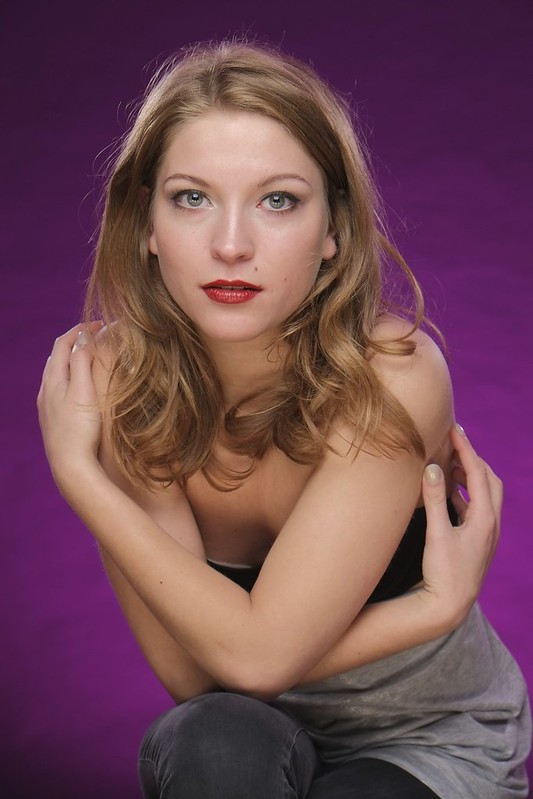
Even at f/5.6, the wrinkles in the background roll are clearly visible and kind of distracting in this unprocessed SOOC Provia JPEG. It took me about a minute to blacken the purple and enhance the skin tones in Apple Aperture:
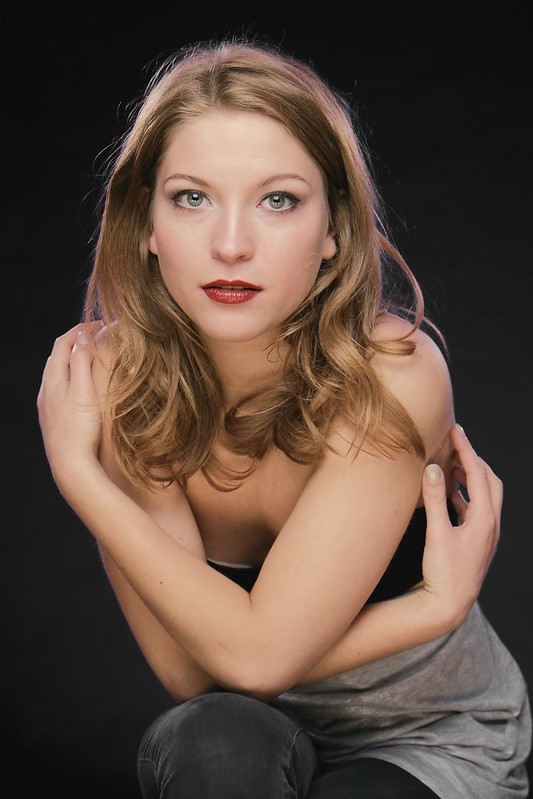
However, there are reflections of the (formerly) purple background in the model’s hair. For me, going black&white was the best and most simple solution to enhance this JPEG:
(Over-)Complicating things doesn’t automatically lead to better results, and I think one of Damien’s most formidable strengths is his talent for simple setups with just one or two artificial light sources.
To further prove my point that simplicity is good, here are two more Elinchrom samples with a simpler, unlit background (further darkened by using a small aperture of f/11):
Unlike our previous “lemon shot”, these images also look quite nice in color:
Using an aperture of f/11 isn’t optimal in conjunction with APS-C-sized sensors due to diffraction kicking in and taking away some detail. Full-frame camera users are better-off in situations like this, so Fuji should do their homework and offer faster flash-sync speeds in their focal plane shutter X-Mount cameras. A maximum speed of 1/180s doesn’t cut it all the time, and even though 1/250s can often be used in the field (at your own risk), it would be nice to have this speed available officially and guaranteed. Another annoyance is the fact that X-E1 and X-Pro1 cameras don’t “remember” intermediate shutter speeds like 1/160s (that can be set using the left and right selector keys). For example, once you review an image with the play button, the camera will automatically revert to its “hard” shutter speed dial setting of 1/125s or 1/250s.
The X100S doesn’t suffer from any of these quirks, as its leaf shutter allows sync speeds of up to 1/4000s. Even better, the X100S also remembers intermediate shutter speed (and aperture) settings, even if you completely switch-off the camera between shots. So at least part of the problem can be solved in firmware. Hope dies last.
Here’s another studio flash setup at f/11, featuring a spectacular corset by Lisa Keating. I specifically like the interplay between our model Wlada and her shadow on the wall:
Speaking of walls and stunning dresses, there’s a lot one can do with natural light—or a daylight lamp like the Lupolux 1200 HMI fresnel spotlight:
To cast the shadows on the wall, Damien used an actual potted plant from Radmila’s studio. Here it is, with Wlada looking like Jane luring Tarzan to follow her into the jungle…
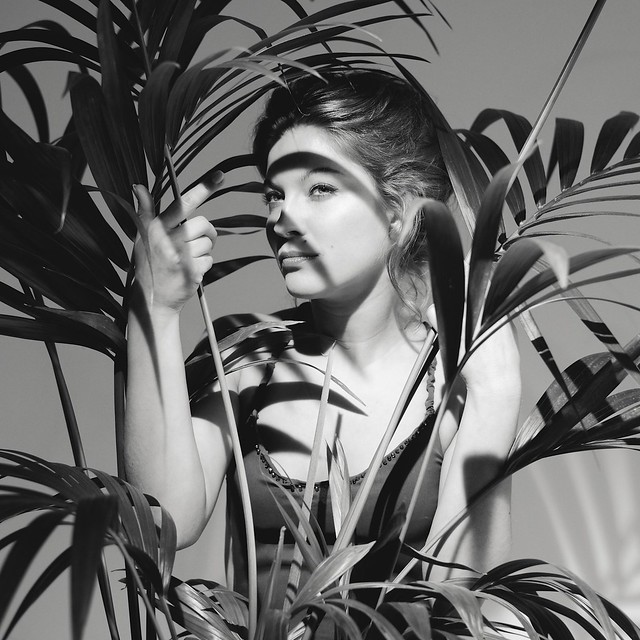
As you can see, everybody was having fun, which is part of the process to get an atmosphere and energy that “works”.
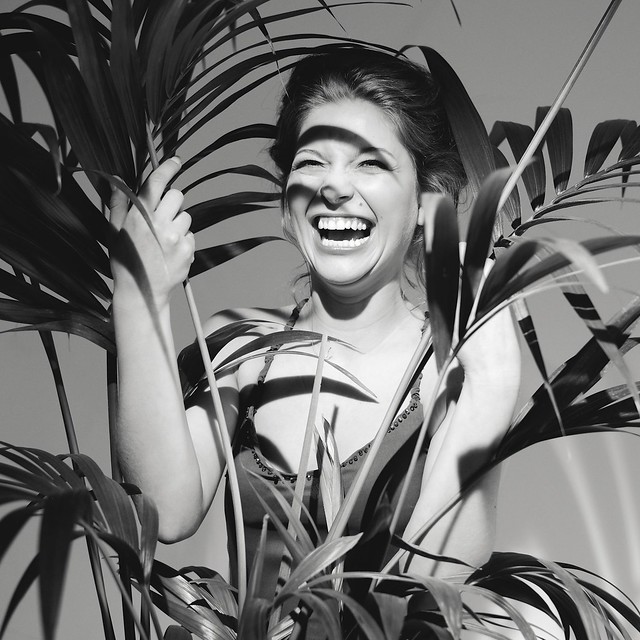
Using the Lupolux, everybody could shoot away at the same time, as there was no flash refresh period to consider. Here’s a series of shots that were taken with this “pot plant” setup:
In addition to improvising with plants, Damien is also using his own “home-made” gels to enhance the quality of light from flash or Lupolights. Here’s a sample series showcasing one of his more subtle gels that’s casting soft, almost cloud-like shadows on the wall:
Using natural light for portraits is quite nice but not really an option on dull days. That’s why Damien once again set up a single Lupolight to simulate the non-existing sunlight coming through our studio window. Along with adequately rich high-key exposure, the results of this straightforward setup were quite charming:
Shooting from above (using a ladder), here’s the X-E1 with the 35mm prime:
And two more shots using the X100S:
And finally, another snap with the X-E1, this time catching Wlada while posing for another photographer:
Even at f/2, autofocus wasn’t an issue with these shots. The X-E1 and X-Pro1 very rarely misfocused, and I shot just as many pictures as my colleagues that were using two Nikon D4 and two Canon EOS 5Mk3 cameras.
Autofocus can be more of a challenge when using flashlight in dimmed ambient light. That’s why modeling lights should be set strong enough to provide sufficient contrast for the camera’s CDAF system to accurately lock onto the target.
For our final series, Damien set up an Elinchrom ring flash. Even at f/10 and f/11, the kit zoom lens on my X-Pro1 was still delivering admirable results.
By the way, Damien provided cheap no-name radio triggers (about USD 100 for a set of eight) that worked perfectly with both the X-E1 and X-Pro1 (as well as the Canikons that were in use).
Once again, here’s the full studio set on Flickr.
EXR, anyone?
Remember when I enquired about your interest in an article covering the inner workings of EXR technology? More than 1,500 FR readers have since voted for such an article, so I am happy to comply. In order to find out about the most pressing questions and issues you may be having with regards to EXR (how it works and how to use it best), I have set up a forum thread. Feel free to contribute and discuss these issues, as that will help me compile a tailored X-Pert Corner article with information that will help you better.
The next edition of this column will be published Wednesday morning with a special report about something I can’t talk about at this time. Stay tuned. :)
For your convenience, here’s a TOC with links to my previous X-PERT CORNER articles:
- Using the X100S
- Using the X20
- X100S vs. X100
- X20 vs. X10
- RAW, JPEG, Silkypix and “Fuji Colors”
- Adapting Third-Party Lenses (updated with Speed Booster)
- RAW for JPEG Shooters…
- Tips for Updating your Firmware
- How to Clean the X-Trans Sensor
- Using the XF14mmF2.8 R
- Decoding XF18-55mmF2.8-4 R LM OIS
- Comparing RAW converters: JPEG vs. Lightroom, Capture One, Silkypix & RPP
- XF14mmF2.8 R appears to be almost distortion free
- How to Expand Dynamic Range
- How to Use Extended ISO
- EXR, anyone?
- Capture One – When the Going Gets Tough…
- Using Shooting Profiles and the Quick Menu
Rico Pfirstinger studied communications and has been working as journalist, publicist, and photographer since the mid-80s. He has written a number of books on topics as diverse as Adobe PageMaker and sled dogs, and produced a beautiful book of photographs titled Huskies in Action (German version). He has spent time working as the head of a department with the German Burda-Publishing Company and served as chief editor for a winter sports website. After eight years as a freelance film critic and entertainment writer in Los Angeles, Rico now lives in Germany and devotes his time to digital photography and compact camera systems. His book “Mastering the FUJIFILM X-Pro1” (Kindle Edition) (Apple iBook Store) (German version) is available on Amazon and offers a plethora of tips, secrets and background information on successfully using Fuji’s X-Pro1 and X-E1 system cameras, lenses and key accessories.


